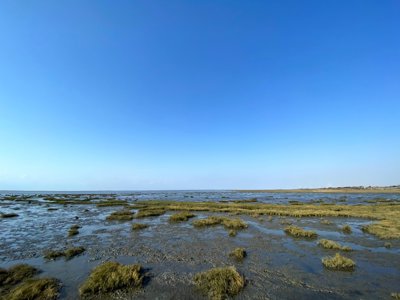Research from the Cambridge Coastal Research Unit at the University of Cambridge on coastal wetlands has substantially changed awareness, attitudes, policy, and practice within governments and organisations concerned with flood and coastal erosion risk management and hazard mitigation.
Issue
Protecting lives, livelihoods and infrastructure at the coast with fixed, ‘hard engineered’ defences alone is expensive and ultimately not sustainable with rising sea levels and increases in storminess. Even a modest sea level rise of 0.5m by 2100 is projected to make 1,000 km (20%) of all coastal defences in England vulnerable to failure.
Approach
The Cambridge Coastal Research Unit field campaigns in the Essex estuaries, Morecambe Bay, and across the European Union have provided evidence regarding the degree to which wave energy is reduced when saltmarshes are inundated during high tides/storms.
In two true-to-scale experiments in the world’s longest wave flume, research demonstrated that wave heights were lowered by 15-20% when only a 40m-wide salt marsh buffer zone was present, with 60% of this effect due to the presence of plants on the surface.
Research has also involved incorporating the results from field monitoring and large-scale experimentation into coastal models which contain metrics of the natural coastal protection function.
Impact
The research has enabled policy authorities to quantify the benefit of natural coastal protection, including its effectiveness in reducing wave height incidence and reducing the need for investment in artificial defences. Over a sustained period, the research has helped UK policymakers recognise the societal benefits, monetary and non-monetary, of coastal habitats in coastal protection schemes.
Natural England have used the research to help grow and disseminate the environmental evidence relating to natural coastal protection, in particular the role of saltmarshes both in general advice and in site-specific cases.
The team have worked closely with the Department for Environment, Food & Rural Affairs Marine Pioneer and local stakeholders to develop robust metrics to quantify the benefits, or ‘environmental gain’, from a natural capital approach at specific sites.
Research has helped The National Trust, the UK’s largest private landowner, to develop and assess strategies for natural capital benefit in relation to its coastal areas, which represent one fifth of the coastline of England, Wales, and Northern Ireland.
Share this resource
This is an open access article under the terms of the Creative Commons Attribution License (CC BY NC 4.0), which permits use, adaptation, distribution and reproduction in any medium or format, provided the original work is cited and it is for non-commercial purposes. Please contact us for other uses.
How to cite
Royal Geographical Society (with IBG) (2023) Natural coastal protection and risk reduction by intertidal wetlands. Available at https://rgs.org/intertidalwetlands Last accessed on: <date>
